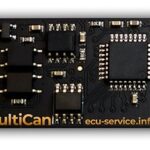The Caterpillar 3126 HEUI (Hydraulically Electronic Unit Injection) fuel system is known for its robust performance. However, like any complex system, it can experience issues. One common problem is HEUI pump failure, often indicated by specific symptoms. This article will delve into the symptoms of Cat 3126 HEUI pump failure, focusing on low-pressure problems, based on a real-world troubleshooting experience.
Understanding the Problem: Low HEUI Pressure at Idle
A 2000 M1088A1 military truck equipped with a Cat 3126 engine experienced a check engine light (CEL) accompanied by diagnostic trouble codes (DTCs) 164-11 and/or 164-2. These codes point to a mismatch between the desired and actual injection activation pressure in the HEUI system. The primary symptom was the inability of the HEUI pump to achieve the low-end pressure required at idle. While the pump maintained correct pressure at higher RPMs and under load, it consistently failed to drop below 1000 psi at idle, despite a target pressure of 870 psi.
Example of a CAT ET diagnostic screen displaying HEUI pressure readings.
Initial Troubleshooting Steps: Sensor and Oil Change
The initial troubleshooting steps focused on the most common causes of this issue: the HEUI pressure sensor and the pressure control valve (also known as the Injection Actuation Pressure Control Valve or IAPCV). Replacing the pressure sensor did not resolve the problem. Further investigation revealed that while idling, the actual pressure remained high, but under throttle, the system functioned correctly, suggesting the issue was primarily at low engine speeds. After encountering limp mode and even higher minimum pressures (around 2000 psi) after driving through challenging terrain, an oil change to 30w was performed. This resulted in a partial improvement, restoring pressure readings to normal ranges except for the persistent low-end idle pressure issue.
A close-up of a HEUI Pressure Control Valve (IAPCV).
Suspect Component: The IAPCV
After the oil change and further driving (a 1200-mile trip), the problem remained isolated to the low-end pressure at idle. The next step in the diagnostic process is to replace the IAPCV (CAT p/n 122-5053). The IAPCV controls the oil pressure supplied to the HEUI injectors and is a critical component in maintaining correct fuel injection pressure. A malfunctioning IAPCV can lead to insufficient pressure at idle, resulting in rough running, poor fuel economy, and potential engine damage.
Conclusion: Next Steps and Seeking Further Input
The symptoms experienced point towards a potential IAPCV failure as the root cause of the low HEUI pressure at idle. Replacing the IAPCV is the logical next step in resolving this issue. However, it’s always beneficial to learn from others’ experiences. Have you encountered similar symptoms with a Cat 3126 HEUI system? Sharing your knowledge and insights can help others diagnose and fix similar problems. Understanding the symptoms of Cat 3126 HEUI pump failure, particularly low-pressure issues, is crucial for effective troubleshooting and repair. This case study provides valuable insight into the diagnostic process and highlights the importance of systematic troubleshooting to pinpoint the root cause of the problem.
